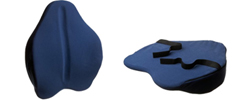Tips to Prevent Lower Back Pain
Approximately 80% of the population in the western world will experience low back pain during their lives. Low back pain represents the single greatest expenditure of health care resources in our society today. It results in millions of dollars of lost work every day. Most low back pain is preventable.
It is often caused by lack of exercise, overuse, poor posture and poor work or exercise positioning. Obesity causes low back pain by increasing weight and pressure on the spinal discs in the lumbar region. Smoking also contributes, causing decreased blood flow to the spine and decreased bone density. The good news is that many of these issues can be corrected with proper back support. Use a quality cushion designed for proper back support.
How arthritis contributes: Understanding the anatomy of the spine is necessary to understand the cause of pain. The spine is composed of 24 movable bones called vertebrae, 5 of which make up the low back region called the lumbar spine. The function of these vertebrae is to bear weight, as well as to provide a protective covering for the spinal cord. Between each pair of vertebrae are cushions called discs, which help absorb compressive forces and contribute to the movement of each joint segment in the spine.
These vertebrae and discs work together to create motion in each spinal segment. Because they do move, the joints can move out of alignment and cause irritation and pain. If these misalignments are not corrected over time, spinal arthritis may develop due to the wear and tear caused by the improper motion of the segments. Chiropractic adjustments remove these misalignments and restore proper function, thereby helping to prevent the process of arthritis from occurring in the spine.
How disc injuries contribute:vertebra are shock-absorbing cushions called discs. The spinal cord runs behind the discs and is encased within each vertebra. Between each vertebra is a hole on either side through which the spinal cord branches to communicate with the rest of the body. In the lumbar spine region, these nerves go down the legs, as well as to several organ systems, including the reproductive systems, the colon and the bladder.
The outer portion of the disc is formed by a strong material called the annulus fibrosis, which is composed of concentric rings of cartilage. These rings receive nutrients through osmosis, as they have no direct arterial or venous supply. The nucleus pulposis is the center, gelatinous portion of the disc. It can be pushed outward when compressive forces are applied to the spinal column. As the body changes positions, the discs change their shape constantly.
Over a lifetime, the disc can be damaged by acute injuries (car accidents, falls, etc.) or chronic problems (poor posture, incorrect body movements, etc.) which cause the outer annulus portion to weaken and eventually tear. When this occurs, the nucleus pulposis begins to bulge out, which may cause pressure on an adjacent nerve. This creates pain either in the direct area of the spine or along the path of the compressed nerve (i.e.: down the leg or into the groin region).
How to prevent low back pain: The key to low back pain is prevention. Smoking and obesity both are contributors to low back pain. A proper warm-up before exercise, along with a period of time for stretching after exercising will help to prevent injuries. Stretching and strengthening of the core (abdominal, lower back and oblique muscles) is essential for the prevention of low back pain. Always be aware of posture at work, as well as with every day activities in order to avoid injuries over time. Something as small as this can make a huge difference. Finally, make sure your back is in proper alignment. Chiropractic care can prevent arthritis from forming in the spine and prevents low back injuries, both acute and chronic.
Steven M. Horwitz, D.C., of the White Oak Chiropractic Center in Silver Spring, Maryland, is a graduate of both Cornell University and the National College of Chiropractic. He is certified as a Chiropractic Sports Physician, Strength and Conditioning Specialist, and Personal Fitness Trainer. He served as the chiropractor for the 1996 U.S. Olympic Team and was appointed by the Governor to the Maryland Council on Physical Fitness. Dr. Horwitz is the author of You Can Be Fit and is a popular guest on many radio programs. An avid athlete, he has run marathons and is a champion bodybuilder.





